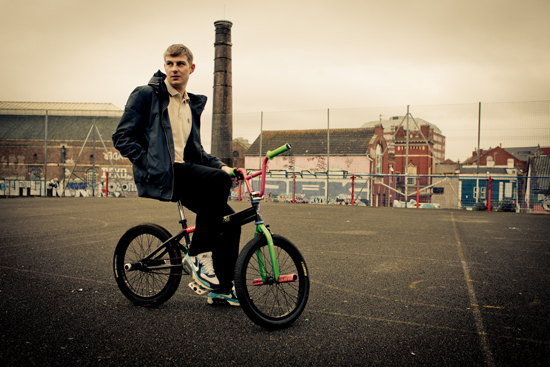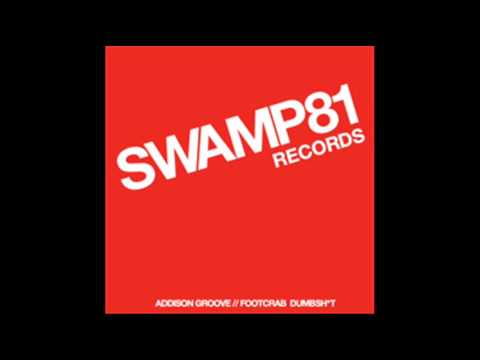Harnessing the schizoid bounce of Chicago juke, the utilitarian drive of techno and the concave sub weight of dubstep into an area both instantly recognisable and entirely his own, under his alias Addison Groove Tony Williams has quickly cemented his position in the UK’s bass spectrum. His ubiquitous 2010 single ‘Footcrab’ – a bone fide, if rather unlikely, anthem – captured the zeitgeist, and the selection of 12”s that followed all worked a hitherto unknown sweet spot: functional ghetto rollers that demanded to be worked hard – idiosyncratic body music marked by alien percussive patterns, vintage drum machine samples and dirty low end bounce.
And at a time when dubstep was to be found inexorably ramping itself into a steroid-pumped, perennially aggy dinosaur, and the UK-centric bass music left in its wake drifted ever closer to house, Addison Groove offered something rather different. In thrall neither to the vulgar excesses of the drop nor the creative safety net of four-to-the-floor derived musical conservatism, he appropriated a hitherto little known sound source – Chicago juke and footwork – into a scene hungry for new cultural markers.
Indeed, his influence in this respect should not be underestimated: only a small number of heads this side of the pond had heard of juke until ‘Footcrab’ – an influence that’s gone on to inform scores of productions over the past couple of years. The story didn’t start with that single, however. Emerging from dubstep’s second wave, Bristolian Williams’ journey into production began in 2006, making sparse and oppressive tracks under the Headhunter moniker. A slew of 12”s for Tempa culminated in the richly satisfying Nomad LP in 2008, which succinctly drew together the menacing influence of late 90s drum & bass with the spacious lines of vintage dub techno.
Last month, however, saw the release of the debut Addison Groove LP, Transistor Rhythm, through Modeselectors 50 Weapons imprint. Something subtly different again, it offers twelve fierce bursts of utilitarian bounce reaching backward to the foundations of ghetto house and forward to juke and footwork, while remaining recognisably UK in origin. They’re tracks certain to feature on heavy rotation in the big rooms from Fabric to Berghain, as well as countless sweaty basements. The Quietus caught up with Williams on the phone from Bristol, to talk about his musical history and the ideas behind Transistor Rhythm.
How did this all start for you then Tony? Didn’t you used to live with Technical Itch?
Tony Williams: Yeah, that’s right. It seems like a hell of a long time ago now! I was living with Mark [Caro, aka Technical Itch] and also Jakes [MC and producer] and had been experimenting with production for a while. I was really into d&b and jungle, had been for years, but I was into the late 90s tech sound – Virus, Ram, Bad Company, you know? The thing is, if you want to make that kind of stuff you need serious production skills: it’s all about the production levels on that side. I’d been dabbling, using the first version of Reason since I was about 19, but I knew I didn’t really want to make d&b.
Then I heard dubstep and at first it was like ‘What is this noise?’ – it took a while to sit with me. I’d already been making tunes that I wouldn’t have really described as dubstep, but they were at that tempo. Pinch heard them and said ‘No, what you’re making is basically dubstep’. After that I thought well, perhaps I could add something, but coming at it from a different angle. There was obviously already a jungle influence, a big dub thing going on in dubstep, but that rolling tech sound that I was into wasn’t there so much. And also the production levels were nothing like d&b. It was something else completely, much rawer – I saw a gap, basically!
I really hear that in your early Headhunter stuff. Particularly the Initiate EP – ‘Drop the Waste’ and stuff like that – it’s got the Virus sound in there.
TW: Big time – that was what I was going for. I was still learning – all the time – it was a big learning curve. Mark and I set up our label [Acension] in 2006 and we had a little bit of attention from that, but nothing major. I was still trying to figure it all out. Once I hooked up with Tempa though, it all happened proper fast.
How did that come about?
TW: Through Appleblim, really, and through a track called ‘7th Curse’ which they heard and really liked. I was at college with Appleblim learning music tech, and he was doing a bit of work for Tempa at the time but also on this course. He was into all kinds of music. He was the one that got me really interested in techno, and dub techno. Basic Channel and stuff like that blew me away, and I guess that also had an influence on the Headhunter stuff.
I was being flown all over the world DJing within 5 months of hooking up with Tempa – within 5 months of even starting to make dubstep! But I still felt new to it, you know? People would ask ‘What’s next, what’s your next tune Tony?’ and I’d almost feel like saying ‘Well, the next tune will be me continuing to figure out what I’m doing. Continuing to learn music production properly. Hopefully it will be better than the last one.’ [laughs] It was all a bit mad, really.
Why the break from dubstep? What happened there?
TW: Something in me died about dubstep a little. It came down to the fact that people just wanted it harder and harder. People would come up to me while I was playing and actually say that – ‘You got anything harder mate?’ – it got really annoying. Either that or they’d be holding phones up, asking for some tune I’d never even heard of, you know?
It was at this time I was getting really into juke music. I was looking for something new, just looking on YouTube and I stumbled across it. I didn’t know if I really liked it or not at first, and that was cool. I just knew that it sounded completely new. It sounded alien – and you can’t often say that about music. I just dived in from there, spent about £40 on tunes on Beatport, went mad and just bought everything that I could find. The vast majority of it was by Spinn and Rashad. It’s a very hidden scene in that sense though, you know nothing about the producers a lot of the time.
So were you playing it out at this stage, or just listening? I think it’s fair to say you were instrumental in bringing juke and footwork to wider consciousness –I should imagine that the overwhelming majority of people involved with electronic music in this country hadn’t investigated it until ‘Footcrab’.
TW: I was starting my sets with it – and juke is at 160 bpm – and was then moving down to 130. I was playing about 10-20 minutes of it at the beginning of my sets. That’s how ‘Footcrab’ came about. I wanted to make something that was a bridge tune, that could be mixed with other stuff – techno or dubstep or whatever – but that still had really recognisable elements of juke without it being a full on juke tune. It had to still be relevant to my history, and what I was doing.
What was the reaction?
TW: Well, it was just sat on my hard drive for a few months. I made it and didn’t really think anything of it. I made it in around April 2009, I guess. Then I played it to Pinch and Peverelist who are good mates and both of them said ‘It’s the best thing you’ve ever done!’ I was a bit surprised, like ‘Really?’ I started playing it a bit and people got into it. But it did take a while. I gave it to Simon from Kryptic Minds and I think he gave it to Loefah, who then asked if I wanted to put it out on Swamp 81 when we were in Outlook. Gradually and gradually it blew up. By April 2010 there was one DMZ where literally every DJ played it, then I was getting texts from Pinch saying ‘Footcrab’s just blown up Fabric’!
With your subsequent 12”s on Swamp 81, and certainly with your new LP, I get a strong juke influence but it’s tempered by a real tightness and control – do you think this is fair?
TW: Yeah, because everything I do is done in the context of the UK dancefloor, it’s done with that in mind. First and foremost, that’s where it has to work. So with the new album I had a clear vision of what I wanted to do. With Addison Groove stuff, from the start the idea was to bring new sounds in – the 808 thing, the whole juke thing, a more tribal aspect – but have it in touch with the UK, if that makes sense.
You mean UK soundsystem culture?
TW: Exactly. That’s a good way of putting it. That’s what I come from, and there always has to be a connection to that in everything I do. The way things have gone now, in that respect, seems like a step backwards, the whole house thing.
I know a lot of people now, and they’re playing house music, and that’s all good but it feels a bit safe, perhaps? I really like house music, but if I want to listen to proper house music I’ll listen to someone like Kerri Chandler, right – someone who knows that stuff inside out.
This is why I could never understand why people weren’t actually playing juke, a lot of people dismissed it. There was a lot of discussion about it, and a lot of people were influenced by it, but there were hardly any DJs actually playing the music. It works so well on the dancefloor though. People love it, crowds were going off to it. The rhythms are incredible, so complex, the bass is insane. It felt a bit like ‘So, you’re going to dismiss this, but you’re happy to play house music. Well, ok.’
That’s something I really get from your new LP. When I heard it, from a DJing perspective I was itching to go and have a mix, straight away. I wanted to test them all out. Every single track is really mixable, it’s a proper dancefloor album.
TW: Juke influenced the way that I DJ, big time, and that’s influenced the way that I write. For a start, the tunes are all quite short: the tunes on the LP are all around three or four minutes. It comes from mixing, capturing energy, wanting to create spontaneity, that thing where you don’t have the time to even look at the record, you’re just grabbing it and off you go, creating a more spontaneous DJ set. You’re not planning what you’re playing, you’re just in the moment.
I thought about that for the vinyl version of the LP: all the sides go together really well, I wanted to make sure that you could play the album properly, from a DJ perspective. They’re not that easy to mix though, you have to be quick. Apart from the club, I first put the album on in the car I think: the car test. And the car test worked really well, so I’m happy with it.



